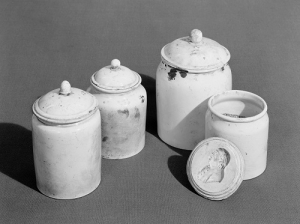14. Early Scientific Applications and the Role of Pottery Manufacturers
| 1837 Page: 363 of 418 Go To Page: | ◁◁ First | ◁ Previous | Next ▷ | Last ▷▷ |
14.2 Wedgwood
Josiah Wedgwood was one of the British pioneers of the artistic pottery industry, but he was also one of the early activists in scientific ceramics. As mentioned earlier he had contracted smallpox as a child that damaged his right leg. A riding accident caused further damage, so a notable surgeon, Matthew Turner from Liverpool, was called to attend to Wedgwood’s leg in 1762, and this meeting led to a close and longstanding friendship. Like Wedgwood, Turner was very interested in chemistry and introduced Joseph Priestly to the subject, and the three worked closely together. Priestly was later to become a noted experimental chemist. Wedgwood carried out extensive experiments in ceramics and assembled a huge library for his research. In the 1770’s he was working on the development of ceramics to be used by chemists, druggists, apothecaries and surgeons. Examples are earthenware retorts, distilling and melting pots, crucibles, filter funnels, chemical storage jars, measuring cups and levigators (grinders for powder).

Wedgwood 18th century evaporating pan and
stoneware crucible - image courtesy of the
Wedgwood Museum
However, the most successful product in the last quarter of the 18th century was the pestle and mortar.

Wedgwood mortars and pestles - image courtesy
of the Wedgwood Museum and James Watt’s
equipment, courtesy Science Museum, SSPL
The alternatives at the time were made of insufficiently robust ceramic, bell metal (but there was a fear that small metal particles ground off would poison patients) or made of marble, but that was attacked by acids and absorbed oily substances. After one meeting with Priestly, Wedgwood noted that “the Doctor seems much at a loss for a mortar, not (made of) metal, for pounding on. Make him a deep one or two”. It took six months to perfect, rather longer than he had envisaged, but by July 1779 he had succeeded. Initially, in the early 1780’s, Wedgwood gave away this equipment to further chemical research, however, demand grew and it became a good business.
Wedgwood carried out a great number of experiments between 1781 and 1793, which were recorded in his Experiment Books. A number of these concerned the design of furnaces and kilns. At the time it was very difficult to get consistent firing in kilns, as there was no way to measure the temperatures achieved. Considerable amounts of product were wasted by under or over firing, so Wedgwood set out to find a way of recording the temperature reached in a given firing. He spent much time experimenting with the colour change in clay samples at different temperatures, with the idea that a series of unfired samples left in particular areas of the kiln could, after a firing, be compared with colour standards to give the temperature that part of the kiln had reached. He referred to this as his Colour Thermoscope, but it was thought too subjective in making the colour comparisons. He then went on to investigate the characteristic of clay to shrink on firing, using small clay cylinders, which proved to be quite repeatable if the clay composition was carefully controlled. To make the method objective, he made a gauge by fastening two rods together at a small angle and calibrated it so that when cylinders were inserted between them the degree of shrinkage, hence the temperature reached, could be measured. This device was one of the first pyrometers. It was as a result of this work that he was elected a Fellow of the Royal Society in 1783.
Some 800 years earlier it is reported that potters in the Chinese Northern Song period (960-1127 AD) used cone shapes 5cm tall to help firing in their kilns. In 1886 the Segar cones developed by the German, H. Sager, became the standard for temperature measurements in kilns.
Wedgwood met and supplied many other scientists and engineers, including James Watt and Matthew Bolton. Often they would specify particular articles they needed and Wedgwood would work with them to achieve the desired ceramic product. He was consulted by the French scientists Lavoisier and Seguin regarding the lining for a furnace to melt platinum. Many scientific products were exported, for example to Landriani, a notable chemist in Italy.





